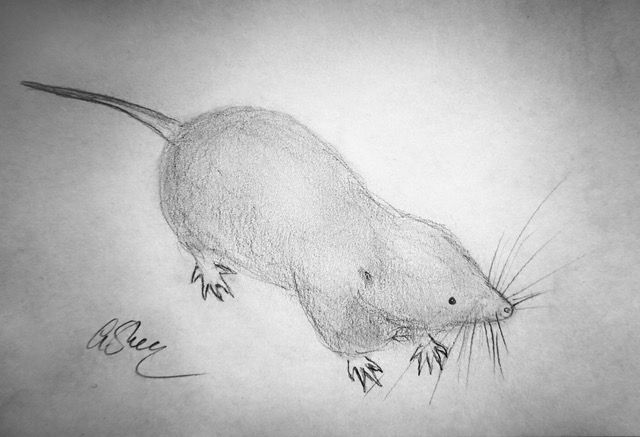The Mystery of the Shrews
It is still a mystery why the shrews in my yard died. They had almost made it through the winter.

A small, furry animal ran from under my chickens’ trough. In the split second before it vanished I glimpsed a solid gray velvet coat and short tail. This was not a mouse but a short-tailed shrew. The next day the animal was again under the trough, but dead. Another of the same species lay dead not far off. I examined the small corpses. They showed no sign of injury or disease. Why then did they die?
Although they are numerous, shrews are secretive and seldom seen. They bear a superficial resemblance to mice, but are unrelated. Shrews are insectivores like moles and hedgehogs, whereas mice are rodents like rats, squirrels, etc. If you could compare a shrew and a mouse side by side, you’d notice the shrew has a more pointed snout, tiny eyes, barely visible ears and fur that can be brushed in any direction. They lead a cryptic and solitary life under leaf litter, in runways beneath vegetation and in burrows.
Despite being small, shrews live a fast-paced life and are ferocious predators. Their metabolism is set in overdrive, with a heart that beats around 800 times a minute for a short-tailed shrew (one of the larger shrews) and 1200 times a minute for the pygmy shrew. This is the fastest heart rate among mammals. Footage of shrews show they appear ‘nervous and twitchy’ moving on average 12 times a second.
They are compelled to eat a lot to fuel this metabolism. It is estimated that they consume up to three times their own weight in food every day. Shrews that cannot find food may die within a few hours. They are always on the hunt not only for insects, slugs, snails and worms but larger prey too. Shrews fiercely attack and kill animals larger than themselves, including mice, salamanders, frogs and snakes. How such a puny creature could do this was a mystery till it was discovered that the short tailed shrew has a secret weapon. It is one of maybe four mammal species in the world that are venomous. Shrew saliva contains a neurotoxin that paralyses their prey. This allows them to take down animals that dwarf them. It also bestows the option of storing their immobilized but ’undead’ victims in a larder as insurance against hard times.
Shrews do not hibernate, remaining fully active all winter under the snow. Studies on common European shrews reveal a striking adaptation to reduce the threat of winter starvation. In the summer of their birth they grow rapidly to their full size but come fall and through winter they shrink by as much as 20 percent. Their muscles, internal organs and spinal column all get smaller. Remarkably, so do their brains, by as much as 30 percent, with the height of the skull’s braincase shrinking by a little over 15 percent. The strategy seems to be that a smaller body requires less food, as insects, the mainstay of the diet, are absent. Small-brained winter shrews exhibited some degree of cognitive impairment in laboratory learning experiments, but evidently this is an acceptable trade-off.
In the spring shrews begin to grow again. Their braincases recover by 9 percent and their body mass rebounds till they are about 80 percent larger than their winter low. Breeding is a prominent part of their life, females have two or sometimes three litters between spring and fall. Most shrews do not live past this second year. Unlike rodents, whose front teeth grow continuously, shrew teeth do not grow. Their teeth become worn due to their constant chewing on crusty snails, dirt-filled earthworms and the like.
It is still a mystery why the shrews in my yard died. They had almost made it through the winter. Maybe whatever food there was finally ran out. Or maybe their fast and furious lives just exhausted their little bodies.
